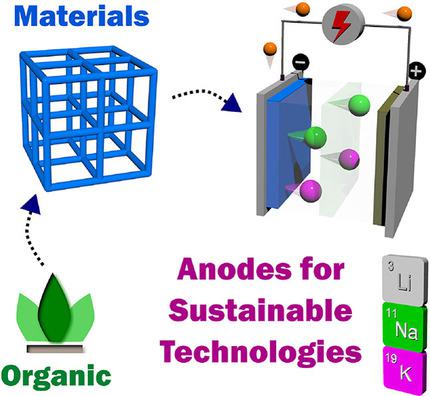当前位置:
X-MOL 学术
›
ChemSusChem
›
论文详情
Our official English website, www.x-mol.net, welcomes your feedback! (Note: you will need to create a separate account there.)
Advances in Organic Anode Materials for Na-/K-Ion Rechargeable Batteries.
ChemSusChem ( IF 8.4 ) Pub Date : 2020-07-16 , DOI: 10.1002/cssc.202001334 Aamod V Desai 1, 2 , Russell E Morris 1, 2, 3 , A Robert Armstrong 1, 2
ChemSusChem ( IF 8.4 ) Pub Date : 2020-07-16 , DOI: 10.1002/cssc.202001334 Aamod V Desai 1, 2 , Russell E Morris 1, 2, 3 , A Robert Armstrong 1, 2
Affiliation

|
Electrochemical energy storage (EES) devices are gaining ever greater prominence in the quest for global energy security. With increasing applications and widening scope, rechargeable battery technology is gradually finding avenues for more abundant and sustainable systems such as Na‐ion (NIB) and K‐ion batteries (KIB). Development of suitable electrode materials lies at the core of this transition. Organic redox‐active molecules are attractive candidates as negative electrode materials owing to their low redox potentials and the fact that they can be obtained from biomass. Also, the rich structural diversity allows integration into several solid‐state polymeric materials. Research in this domain is increasingly focused on deploying molecular engineering to address specific electrochemical limitations that hamper competition with rival materials. This Minireview aims to summarize the advances in both the electrochemical properties and the materials development of organic anode materials.
中文翻译:

钠/钾离子充电电池有机阳极材料的进展。
在寻求全球能源安全的过程中,电化学储能 (EES) 设备正变得越来越重要。随着应用的增加和范围的扩大,可充电电池技术正在逐渐寻找更丰富和可持续系统的途径,例如钠离子(NIB)和钾离子电池(KIB)。开发合适的电极材料是这一转变的核心。有机氧化还原活性分子由于其氧化还原电位低并且可以从生物质中获得,因此成为负极材料的有吸引力的候选者。此外,丰富的结构多样性允许集成到多种固态聚合物材料中。该领域的研究越来越集中于利用分子工程来解决阻碍与竞争对手材料竞争的特定电化学限制。本综述旨在总结有机负极材料的电化学性能和材料开发方面的进展。
更新日期:2020-09-24
中文翻译:

钠/钾离子充电电池有机阳极材料的进展。
在寻求全球能源安全的过程中,电化学储能 (EES) 设备正变得越来越重要。随着应用的增加和范围的扩大,可充电电池技术正在逐渐寻找更丰富和可持续系统的途径,例如钠离子(NIB)和钾离子电池(KIB)。开发合适的电极材料是这一转变的核心。有机氧化还原活性分子由于其氧化还原电位低并且可以从生物质中获得,因此成为负极材料的有吸引力的候选者。此外,丰富的结构多样性允许集成到多种固态聚合物材料中。该领域的研究越来越集中于利用分子工程来解决阻碍与竞争对手材料竞争的特定电化学限制。本综述旨在总结有机负极材料的电化学性能和材料开发方面的进展。


























 京公网安备 11010802027423号
京公网安备 11010802027423号